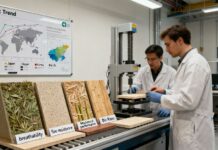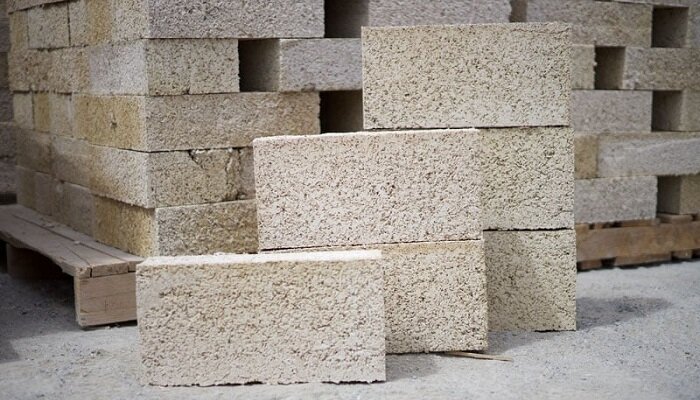Lifecycle Assessment- LCA establishes a framework for evaluating various potential scenarios within a material’s lifecycle, pinpointing key process parameters needing improvement. As a fundamental reality model, LCA involves multiple steps defined by international standards. This article explores the LCA of sustainable building materials, assessing their environmental impacts from production to disposal.
Plastic Waste
Plastic waste, notably polyethylene terephthalate (PET), can be integrated into building materials like concrete and mortars, offering cost reduction, enhanced properties, increased bio-corrosion resistance, and lower energy consumption. The lifecycle of PET waste generally follows three paths: landfilling, incineration, or recycling. Landfilling and incineration pose environmental risks, including soil contamination and air pollution, respectively. Recycling PET involves collecting and sorting PET bottle waste, removing non-plastic elements, compressing, washing, and chopping the bottles into flakes for recycling and construction use.
In construction, the LCA of PET in structural components like walls considers various end-of-life scenarios, including direct reuse or demolition, depending on user practices. PET recycling proves advantageous over other disposal methods. It not only diminishes the environmental hazards linked to landfilling and incineration but also allows the PET to serve a new purpose in construction, furthering sustainability efforts. The process of recycling PET involves a series of steps: collection, segregation from other debris, removal of labels and caps, compression, washing, and finally, chopping into flakes or other forms suitable for construction use. These steps ensure that the recycled PET is clean and prepared for incorporation into building materials.
Natural Earthen and Bio-based Materials
Using natural materials like cob, light straw clay, and rammed earth in building structures creates a comfortable indoor atmosphere and significantly reduces energy consumption. The LCA of these materials shows they can decrease energy use by 32-59% in hot deserts, 29-55% in semi-arid regions, 46-73% in Mediterranean climates, 34-57% in temperate zones, and 27-50% in continental climates compared to traditional methods.
The operational impacts of these materials depend on their thermal properties and regional climate. They offer substantial environmental benefits over traditional materials, reducing embodied energy consumption by 38-83%, climate change potential by 60-82%, air acidification by 57-98%, and particulate pollution by 27-99%. Combining operational and embodied impacts, the LCA indicates that natural earthen and bio-based assemblies have a lower total environmental load than insulated traditional structures, even after 50 years of use.
Despite their advantages, natural materials have yet to gain widespread adoption due to a lack of technical data on their energy performance in various climates and the absence of comprehensive environmental parameters for consistent evaluation throughout the design phase. The benefits of using natural materials extend beyond mere environmental impact reduction. They also contribute to the well-being and comfort of building occupants by creating healthier indoor environments. The thermal properties of these materials help regulate indoor temperatures, reducing the need for artificial heating and cooling, thus saving energy and lowering utility costs. However, the lack of widespread adoption of natural materials in the construction industry highlights a gap in research and awareness. More studies are needed to provide comprehensive data on the performance of these materials in different climatic conditions and to establish standardized evaluation criteria. This would enable architects, builders, and policymakers to make informed decisions about incorporating natural materials into construction projects.
Supplementary Cementitious Materials (SCMs)
Materials like granulated blast furnace slag (GBS), fly ash, plastic powder, and bagasse ash are being investigated as sustainable SCMs to partially replace cement, reducing construction costs and enhancing eco-friendliness. LCA comparisons among ordinary Portland cement (OPC), ground granulated blast furnace slag (GGBS), and Portland pozzolana cement (PPC) show that OPC concrete has a significantly larger environmental impact and carbon footprint across various metrics.
The LCA for these materials covers raw material extraction, energy consumption, transportation, and concrete preparation, with the preparation phase being a major contributor to climate change due to CO2 emissions. While derivatives from iron production and thermal power generation are hazardous, using them as SCMs can mitigate the environmental impact of concrete production. Industrial by-products like GGBS and fly ash used as binders in concrete decrease the demand for natural resources and promote sustainable concrete, reducing adverse effects on human health, marine ecosystems, and freshwater sources.
SCMs offer a viable solution to the environmental challenges posed by traditional cement production. By utilizing industrial by-products, the construction industry can reduce its reliance on natural resources and minimize the negative impact of concrete on the environment. The LCA of SCMs demonstrates their potential to lower CO2 emissions and decrease the overall environmental footprint of construction projects. Furthermore, the use of SCMs can enhance the properties of concrete, such as its durability, strength, and resistance to chemical attack, making it a more sustainable and long-lasting building material.
Cross-laminated Timber (CLT)
CLT has emerged as a sustainable alternative to steel/concrete in the building sector, offering a low carbon footprint, high strength-to-weight ratio, easy installation, and aesthetic appeal. First used in structural applications in the early 1990s, CLT buildings have a 40% lower carbon footprint than traditional steel/concrete-based multi-story buildings, accounting for only 0.05 to 6.3 tons of CO2 equivalent per m² floor of greenhouse gas emissions. This variation depends on factors like local climate, regulatory standards, resident behavior, building height and shape, electricity mix, LCA methodology, and data sources.
CLT is traditionally used in residential buildings but is now being combined with reinforced concrete for structural applications in large government projects and commercial infrastructure. The integration of CLT in construction projects presents numerous benefits. Its high strength-to-weight ratio makes it ideal for use in multi-story buildings, reducing the need for heavy structural components and minimizing construction costs. Additionally, CLT’s aesthetic qualities, such as its natural wood appearance, contribute to the visual appeal of buildings, making it an attractive choice for architects and designers.
The environmental benefits of CLT extend beyond its carbon footprint. The production of CLT involves less energy and resource consumption compared to traditional building materials like steel and concrete. Moreover, wood, the primary material for CLT, is a renewable resource, and sustainably managed forests ensure a continuous supply without depleting natural resources. The use of CLT also promotes carbon sequestration, as trees absorb CO2 during their growth, storing it within the wood fibers.
Challenges and Future Prospects
Not all seemingly sustainable materials are genuinely eco-friendly. A recent study compared two optimized geopolymer (GP) mortar formulations for 3D printing with traditional 3D-printed Portland cement mortar. While GP mortars showed promising properties for high-performance applications, their environmental credentials were unclear. LCA revealed that 3D-printed GP technology is not fully developed, and its immediate applications may not be environmentally beneficial. Despite GPs’ potential to reduce greenhouse gas emissions, their use in GP mortars could increase human and environmental risks, deplete natural resources, and elevate fossil fuel consumption.
LCA is a robust tool for evaluating the sustainability of building materials. Its accuracy and efficiency can be enhanced by incorporating advanced technologies. Integrating large language models (LLMs) with LCAs can refine the precision and speed of evaluations, improving our understanding of the ecological impacts of construction materials, methods, and processes. LLMs facilitate data collection and analysis, supporting more informed and sustainable decision-making in the construction industry.
The integration of LLMs into LCA methodologies represents a significant advancement in the field of sustainability assessment. LLMs, trained on extensive textual data, can process and analyze large volumes of information quickly and accurately. This enables more comprehensive and detailed evaluations of the environmental impacts of construction materials, leading to better-informed decisions and improved sustainability outcomes.
For instance, a study demonstrated the use of LLMs in evaluating bacterial cellulose aggregates as a bio-based alternative building material. The integration of LLMs in the LCA process allowed for a more thorough assessment of the material’s environmental performance, highlighting its potential as a sustainable option for construction. These kind of innovative approaches can indeed go on to refine the precision as well as speed of LCA evaluations, elevating the understanding of the ecological impacts of construction materials, methods along with the processes.






























